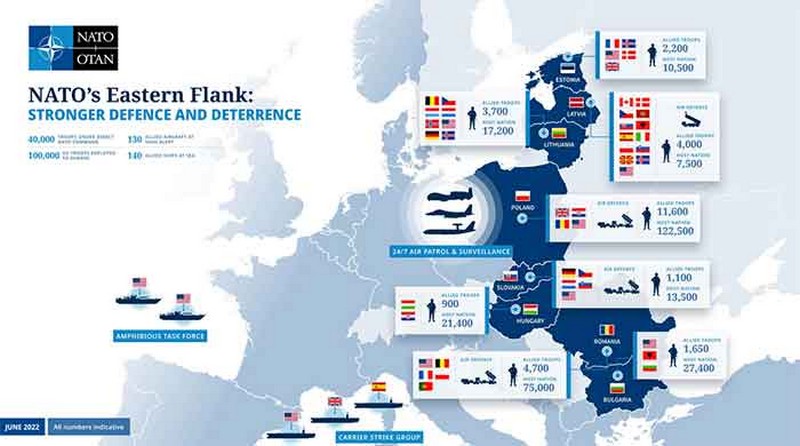By Andre Damon
NATO foreign ministers met in Bucharest, Romania, on Tuesday, along with representatives of the prospective NATO members Ukraine, Finland, and Sweden to discuss a further expansion of the NATO war with Russia in Ukraine and the stationing of more troops on Russia’s Western borders.
“In response to Russia’s full-fledged invasion of Ukraine, we are raising the readiness of our troops,” said NATO Secretary-General Jens Stoltenberg at the start of the meeting. “And we have doubled the number of NATO battlegroups from four to eight. Including one here in Romania, led by France.”
“We have increased our presence on the ground, we have more presence in the air,” Stoltenberg said.
He continued, “Just last week, NATO Allies conducted an exercise to test air and missile defenses in Romania. Involving Spanish, Turkish and US aircraft, as well as French jets flying from the aircraft carrier Charles de Gaulle. Demonstrating how NATO Allies operate together and are ready to defend every inch, but also the airspace above NATO Allies.”
The “airspace above NATO Allies” is rapidly expanding, with Stoltenberg all but treating Finland and Sweden as members of NATO. He declared, “Their membership of NATO is a game-changer for the European security architecture. It will make them safer, our Alliance stronger and the Euro-Atlantic area more secure.”
Stoltenberg doubled down on NATO’s involvement in the war with Russia, saying, “So our message from Bucharest is that NATO will continue to stand with Ukraine for as long as it takes. We will not back down.”
Behind the scenes, these general pledges of expanded NATO involvement in the war are being filled out with concrete discussions to send US fighter jets, long-range missiles, and attack drones into the warzone.
In an article that appeared in Bloomberg, James Stavridis, NATO’s former Supreme Allied Commander Europe, declared that the “West’s best option will be to significantly increase its assistance to Ukraine on the air war side of the conflict.”
Stavridis claimed that NATO members are actively discussing sending US fighter jets to Ukraine, saying, “Leaders in NATO capitals are also revisiting an idea that was discarded in the early days of the war: providing either MiG-29 Soviet-era fighters (the Poles have offered to transfer them to the Ukrainians) or even US surplus F-16s, a simple-to-learn multi-role fighter.”
In an interview with Bloomberg, Latvian foreign minister Gabrielius Landsbergis said that NATO should “allow” Ukraine to strike targets inside of Russia, saying, “We should allow Ukrainians to use weapons to target missile sites or air fields from where those operations are being launched.” He added that NATO “should not fear” the response from Russia.
Ahead of the meeting, Landsbergis tweeted, “My message to fellow foreign ministers at today’s NATO meeting is simple: Keep calm and give tanks.”
Such calls were closely coordinated with demands by Ukrainian officials. “No eloquent speech will say more than concrete action. ‘Patriot’, ‘F-16’, or ‘Leopard’ for Ukraine,” tweeted presidential adviser Mykhailo Podolyak – referring to US F-16 fighter jets and German Leopard battle tanks.
A group of US senators have meanwhile issued a letter calling for the United States to provide lethal armed attack drones to Ukraine, the so-called “Grey Eagle,” which they praised for its “lethality.”
They note, most importantly, that armed Unmanned Aerial Systems (UAS) could find and attack Russian warships in the Black Sea.
They declare that “The MQ-1C, along with already provided long-range fires capabilities, provides Ukraine additional lethality needed to eject Russian forces and regain occupied territory.”
The signatories include Joe Manchin, a key Senate ally of US President Joe Biden, and Trump ally Lindsay Graham.
In an indication of the degree of tension surrounding the conflict, this week Russia canceled nuclear talks with the US at the last minute.
Deputy Foreign Minister Sergei Ryabkov said that “We are sending signals to the Americans that their line of escalation and ever deeper involvement in this conflict is fraught with dire consequences. The risks are growing.”
As the US intervenes ever more directly in the conflict, its military strategists are expressing their aims all the more bluntly. In an essay entitled “United States Aid to Ukraine: An Investment Whose Benefits Greatly Exceed its Cost,” veteran US geostrategist Anthony H. Cordesman acknowledges that “the war in Ukraine has become the equivalent of a proxy war with Russia.”
Cordesman explains that “the U.S. has already obtained major strategic benefits from aiding the Ukraine,” while “Russia is already paying far more of its Gross National Product and economy to fight the war in the Ukraine than the U.S. and its partners, and that Russia has suffered massive losses of weapons, war reserves, and military personnel.”
While Cordesman’s essay treats the deaths of Russian troops and the devastation of the Russian economy as a benefit, it does not anywhere factor in the cost in Ukrainian lives or the suffering inflicted on the Ukrainian population by the war.
Even as the US and NATO continue to pour weapons in to Eastern Europe, Russia has responded with weeks of strikes on Ukraine’s power and water infrastructure, leaving millions of people, including much of the capital of Kiev, without power in the freezing temperatures.
Originally published in WSWS.org
30 November 2022
Source: countercurrents.org

